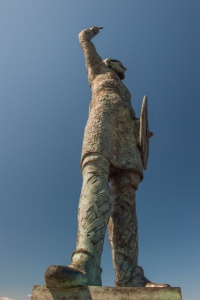
Maldon quayside
Maldon is an attractive hilltop town with a history dating back to the Saxon period.
History
There was a late Roman port here, on low ground on the south bank of the River Blackwater, but the main settlement grew further up the hill, where around AD 914 King Edward the Elder built a fortified town, or burh.
Most people know Maldon as the site of a famous battle between the Saxons and Danes, but actually there were two battles here. Around AD 917 the inhabitants resisted an attack by a force of invading Danes, keeping the area safe from Viking invaders for a time, but that safety was not to last.
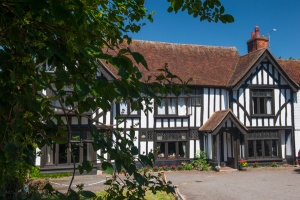
The (Second) Battle of Maldon
Maldon is known to history for one major event, for it was here in about AD 991 that a band of invading Danes landed on Northey Island, bent on plunder. Opposing them on the shore were the Saxon inhabitants, led by a warrior called Brythnoth.
The Danes could only reach land via a tidal causeway joining Northey Island to the mainland, so it would seem that the Saxons had the upper hand.
What happened next is a matter of conjecture, but one version is that Brythnoth allowed the Danes to cross the causeway before giving battle, moved by chivalry. If that was his laudable intent, it backfired badly, for the Danes inflicted a heavy defeat on the Saxons.
Rather than simply plundering the area, the Danes and used their victory to launch a concerted program of settlement, seizing land and making the east of England a Viking kingdom.
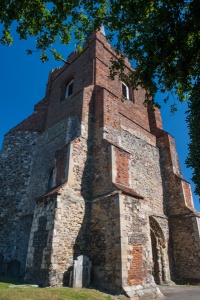
The Hythe
The burh established by Edward developed to become a full-fledged borough, or market town, a regional trading centre and a mint. At the time of the Domesday Book, the manor was held by the king, and the town had its own court. Henry II granted Maldon a town charter in 1171.
Throughout the medieval period there seem to have been ongoing struggles between the crown and townsfolk for trading rights; in 1386 townsfolk held servants of the local lord ransom in a townhouse. Maldon was incorporated in 1554 when the town was granted the right to hold three annual fairs.
Very little of Maldon's economy was based on agriculture; rather fishing and transportation thrived, taking advantage of the Hythe's access to the river. During the post-medieval period much of Maldon's economy revolved around trade through the Hythe, particularly wool export.
Today there are two main sections of town to see; the old historic hilltop area, with its two medieval churches, Moot Hall, and Friary Garden, and at the shore is The Hythe, with its maritime heritage, ancient church, historic Thames barges, and memorial to Brythnoth.
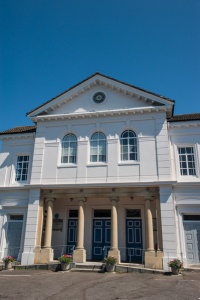
Reformed Church
Go like Billyo
In 1696 a radical Protestant preacher named Joseph Billio purchased a plot of land on Market Hill, and there erected a meeting house for Dissenters. Billio was known for his 'hellfire and damnation' preaching style, which proved enormously popular and attracted increasing numbers of worshippers.
Maldonians insist that Billio's preaching gave rise to the expression, 'like Billy-o', as in 'to go like billy-o'. Though it sounds plausible, the first use of the phrase did not appear until long after Billio's death, and it seems more likely the phrase referred to George Stephenson's raucous 'Puffing Billy' steam locomotive.
There is still a meeting house on Market Hill, though Rev. Billio would not recognise it; his building was deemed unsafe in 1800 and replaced with the current neo-classical United Reformed Church. A plaque erected by the Maldon District Council is set on the porch wall, affirming Maldon's claim to the 'Billy-o' phrase.
WHAT TO SEE
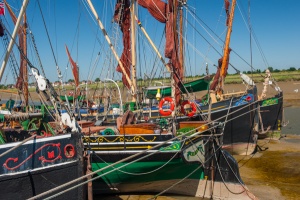
Hythe Quay
Maldon sits upon a prominent hill, overlooking the Blackwater estuary. At the base of the hill is Hythe, originally a separate village, but for over a millennium the port for the town. The quay is strewn with historic buildings, including the 12th-century church of St Mary's (see below). At the base of North Street is Maldon Chandlery, where the man of war 'Jersey' was built in 1654.
The captain was Samuel Pepys, though Pepys's position was purely nominal, and he found the idea of being a naval commander highly amusing. Nearby is the Jolly Sailor inn, a 17th-century traditional pub.
Along the quay are moored several Thames Barges, the oldest being Centaur (built 1895). Another barge, Pudge, was involved in the Dunkirk rescue in WWII. The barges are available for charter and occasionally open to public viewing - but you can always examine them from the quayside.
Near the Thames Barges is the Bath Wall, where a local group of fishermen held 'The Tin Shed Parliament', a regular gathering of prominent fishing families. If you follow the quay past a recreation ground, to the very end of the seawall, you will find Maldon's most recent attraction; a statue of Brythnoth, the Saxon defender of Maldon, defiantly holding a sword aloft, staring toward Northey Island, where the Danish invasion was launched.
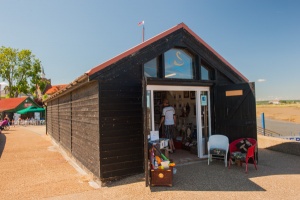
St Mary's
On a sloping hill just above the Hythe stands St Mary's church, its distinctive white spire a beacon to sailors on the Blackwater estuary for centuries (and before that a beacon burned from the top of the tower, serving the same purpose).
St Mary's is known as the fisherman's church, and is older than the parish church of All Saints at the top of the hill. St Mary's dates to about 1130 though it seems likely there was a church here in Saxon times. The Saxon church was probably destroyed by the victorious Danes after the Battle of Maldon in AD 991. Much of the interior has been rebuilt, but there is a Norman window in the north wall.
All Saints Church
This wonderful 13th and 15th-century building has an extremely unusual triangular tower. The south wall, facing onto High Street, has a row of 6 statues in niches, depicting famous people associated with Malson, among them Brythnoth and Thomas Plume.
Within the church is a wonderful 15th-century arcade, decorated with carved faces, and the Washington Window, dedicated to Laurence Washington, a local vicar and ancestor of George Washington, the first American President.
Inside All Saints is the grave of Edward Bright (d. 1750), known as The Fat Man of Maldon. Bright weighed over 32 stone (almost 600 pounds) when he died, aged only 29, and was known as the largest man in England to that date.
In a lane behind All Saints, accessed via Beeleigh Street, is the Old Vicarage, a lovely timber-framed building dating to 1449. The vicarage is not open to the public but it is well worth the short stroll from the church to admire the 15thcentury architecture.
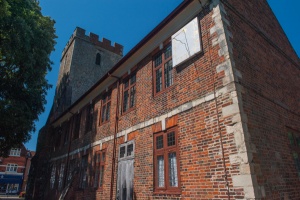
St Peters Church
At the top of Market Hill stands the redundant church of St Peter, with its striking tower acting as a prominent local landmark. The church probably dates to the 12th century, though what we see today is considerably later.
It was never a parish church, but was used by the Guild of the Assumption of Our Lady until falling out of use when the Guild was dissolved in 1549. Only the tower of the medieval church remains, with a later early 18th-century addition built by a wealthy native of Maldon, Thomas Plume.
The upper floor of St Peter's church is occupied by the Plume Library, founded in 1704 from a bequest by Plume, a vicar of Greenwich and Archdeacon of Rochester, who was born in the town.
Plume donated over 8,000 books to his home town, with the provision that they should be put on display in chambers he had built in the redundant church of St Peter. And there are still today, on their original shelves. The historic books cannot be borrowed but can be read at any time. Along with the books, a small collection of paintings donated by Plume are on display.
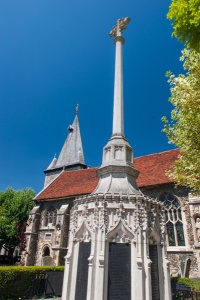
war memorial
The ground floor of the church is now The Maeldune Heritage Centre, offering information on the local history of the area, and a variety of local crafts for sale, while the upper floor is the home of the Plume Library.
The Heritage Centre was launched in 1991 in commemoration of the 1000 year anniversary of the Battle of Maldon. The prize exhibit is The Maldon Embroidery, a 42-foot long wall-hanging depicting scenes from Maldon's history. The Embroidery took three years to complete, and its seven panels were all the work of local volunteers.
In a sense, the Maldon Embroidery is like a local version of the Bayeux Tapestry, a project meant to reflect the history of the area through a series of needlework panels. Other displays include Roman artefacts, prehistoric finds, and a large archive of historic photos.
Moot Hall
An early 15th-century house built by a wealthy official named Robert D'Arcy (see All Saints Church). The Moot Hall features one of the earliest uses of brick for domestic purposes in medieval England. It later served as civic offices, a police station, courthouse, and gaol. Tour the historic chambers and displays of local history, and climb to the roof for views over the town.
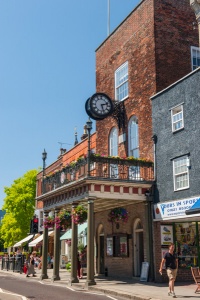
Beeleigh Abbey Gardens
Just outside Maldon the rivers Blackwater and Chelmer converge, and here you will find a riverside garden around the picturesque historic buildings of Beeleigh Abbey. The abbey dates to the 12th century, but the site was transformed in the 17th century into a private residence. The gardens cover 3 acres, with formal gardens, old roses, a cottage garden, wisteria walk, and specimen trees, among other highlights.
Friary Walled Garden
A hidden delight in the midst of Maldon, on the site of a garden owned by Maldon Friary in the medieval period. The friary was dissolved by Henry VIII, but the walled site was later used to create a formal Georgian garden. The original Georgian design has been transformed into a modern wild garden covering only 1/5 of an acre, with paths running between box hedges. Maintained by the Maldon & Heybridge Horticultural Society, the garden is open on the first Sunday of the month.
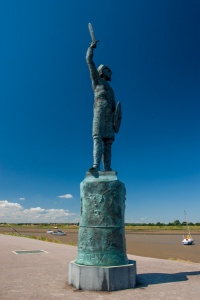
defiant
Northey Island
In the middle of the Blackwater estuary, accessible from the Hythe at low tide, is Northey Island, owned by the National Trust. It was from here that the Danes launched their successful attack in the Battle of Maldon, but today the island is maintained as a wilderness reserve; a peaceful place to enjoy birdwatching, with over 5000 Brent geese spending the winter on the island.
St Giles Hospital
St Giles qualifies as a 'secret treasure' of Maldon, in part because it is located a short distance away from the historic core of the town, on Spital Road. Three wings of a late 12th-century hospital chapel survive from the original foundation, created to offer help to lepers. It is possible that the founder was Henry II.
The hospital soon extended its mission to offer hospitality to any poor or ill person. In 1481 Edward IV granted St Giles to nearby Beeleigh Abbey, but after the Dissolution of the Monasteries, it became a farm building until it was restored in the 1920s. The hospital is owned by the Town Council and is only open by prior arrangement.
Summing up
My goodness, there is a lot to see in and around Maldon. The historic hilltop core is full of attractive older buildings. The quayside area is fascinating for its maritime heritage and associations with the Battle of Maldon. It is fun to visualise how the battle might have unfolded given the layout of the land. I should mention that Maldon sits at the junction of several main roads, and at busy times of day driving up Market Hill from the north can be pretty slow!
About Maldon
Address: Maldon,
Essex,
England
Attraction Type: Town
Location: On the A414, 10 miles east of Chelmsford
Website: Maldon
Location map
OS: TL850070
Photo Credit: David Ross and Britain Express
HERITAGE
 We've 'tagged' this attraction information to help you find related historic attractions and learn more about major time periods mentioned.
We've 'tagged' this attraction information to help you find related historic attractions and learn more about major time periods mentioned.
Find other attractions tagged with:
NEARBY HISTORIC ATTRACTIONS
Heritage Rated from 1- 5 (low to exceptional) on historic interest
Maldon, All Saints Church - 0.1 miles (Historic Church) ![]()
Maldon Moot Hall - 0.1 miles (Historic Building) ![]()
Maldon, St Mary's Church - 0.4 miles (Historic Church) ![]()
RHS Garden Hyde Hall - 6.3 miles (Garden) ![]()
Layer Marney, St Mary's Church - 8 miles (Historic Church) ![]()
Cressing Temple Barns and Gardens - 8 miles (Historic Building) ![]()
Layer Marney Tower - 8.1 miles (Historic Building) ![]()
Chelmsford Cathedral - 8.8 miles (Cathedral) ![]()



